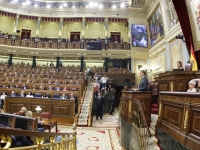Politics
The conservative candidate for Spanish Prime Minister loses the first vote
A new vote will be held on Friday
USPA NEWS -
The candidate for the Presidency of the Spanish Government, Alberto Núñez Feijóo, did not obtain in the first round the absolute majority necessary to be sworn in as President of the Government, so the President of Congress, Francina Armengol, convened the Plenary Session again for Friday, the 29th. September, in order to hold a new vote in which the confidence of the Chamber will be deemed granted if the candidate obtains the support of a simple majority, more votes in favor than against. The conservative candidate obtained 172 votes in favor and 178 votes against
"This debate has been worth it," said the conservative Popular Party candidate this Wednesday, "because we have all portrayed ourselves, with words and with silences," and because it has become clear that "there is an alternative." "I," he stressed, "will emerge from this debate with my principles and those of eleven million voters intact."
The investiture debate, provided for in article 99 of the Spanish Constitution and regulated in articles 170 to 172 of the Regulations of the Congress of Deputies, began on Tuesday at 12:00 p.m. with the intervention of the candidate for president of the Government, who he presented, without a time limit, before the Chamber the Government program that he intends to form and asked Congress for the confidence to do so.
After Núñez Feijóo's intervention, the president of Congress, Francina Armengol, suspended the session at 2:00 p.m. and announced that it would resume at 3:30 p.m. with the intervention of the representatives of the parliamentary groups, in order of greatest to lower for a maximum of 30 minutes.
Specifically, on Tuesday afternoon the Socialist, VOX – far-right -, Plurinational SUMAR – far-left -, Republicano and Junts per Catalunya groups intervened, the latter two supporting the independence of Catalonia. This Wednesday, September 27, the Plenary resumed at 9:00 a.m. with the intervention of the parliamentary groups that did not speak the previous day: Euskal Herria Bildu, Vasco (EAJ-PNV) and the Mixed, which includes the deputies of the Galician Nationalist Bloc, Navarro People's Union and Canarian Coalition. The group to which the candidate belongs, Popular, spoke last.
Once the debate was over, the public vote was carried out by call, that is, the deputies were named one by one, in alphabetical order from a letter chosen at random, so that they could say out loud "yes", "no" or "abstention" from the investiture. In this first vote, the candidate needed the support of the absolute majority of the Chamber, that is, 176 deputies, to be elected President of the Government.
After not reaching this majority, a new vote will be held after 48 hours. In this second debate, which will take place on Friday, September 29 at 12:15 p.m. the candidate will have ten minutes to request the support of the Chamber, and the representatives of the parliamentary groups will have five minutes. In this vote, the candidate will be sworn in as president if he obtains a simple majority, more votes in favor than against. If he obtains it, the president of Congress will transfer him to King Felipe VI so that he can be appointed president of the Executive.
In the event that Núñez Feijóo did not obtain the confidence of the Chamber in this first investiture session, successive proposals could be processed following the same procedure: the King, after consulting the representatives of the formations with a seat in Congress, would propose a candidate through the president of Parliament, Francina Armengol. If within two months of the first investiture vote the President of the Government had not been invested, the King would dissolve both Chambers and call new elections with the endorsement of the President of Congress.
Liability for this article lies with the author, who also holds the copyright. Editorial content from USPA may be quoted on other websites as long as the quote comprises no more than 5% of the entire text, is marked as such and the source is named (via hyperlink).






